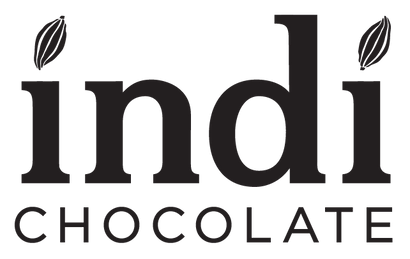Mindful Mediation with Chocolate

Cacao has been a celebrated for hundreds of years, since the Mayan civilization named it, "Fruit of the Gods." Mayans and Aztecs drank cacao as a ritual and during celebrations. It was prepared as a frothy beverage with other herbs and spices.
Fast forward to present day, we find chocolate in everything from cereals to cakes. We find chocolate in everything because there are some major companies that control huge volumes of cacao, they buy low quality cacao from farmers that don't make a lot of money producing it and add a lot of sugar and other ingredients that you probably can't pronounce.
What is the difference between a mass produced chocolate and single origin dark chocolate? For companies like us at indi chocolate, who make bean to bar chocolate, we start with the cacao bean. We roast the bean ourselves and choose cacao that has great flavor to start out with. There are a couple major differences between massed produced chocolate and single origin dark chocolate:
- Cacao beans are fermented: After cacao is harvested it can either be dried and sold OR fermented and dried. The process of fermenting cacao reduces the acidity of the bean and helps the flavor of the bean develop. So instead of covering up the acidity with sugar and milk we can stick to high percentages of cacao when making our chocolate and the beans themselves have complex and delicious flavor profiles.
- Working directly with farmers: This is important for both flavor and the livelihood of the farmers. Cacao that comes directly to us means that there is no time where beans have been stored and sprayed with chemicals. Farmers also receive direct trade pricing for their beans which incentivizes them to produce cacao without chemicals or degradation of the land.
- First ingredient is cacao: It is very important to read the ingredients on a chocolate bar. You may find ingredients that are considered fillers; such as soy, corn syrup, and PGPR (Polyglycerol Polyricinoleate) which is a cheaper ingredient to replace cacao butter. A good rule of thumb is to look at labels with a short list and choose chocolate where the first ingredient is cacao not chocolate.
Mindful Meditation with Chocolate
After understanding the differences in mass produced chocolate vs. single origin chocolate it is time to learn how to practice a full sensory chocolate tasting experience.
How to taste Chocolate:
- Pick three different chocolates to taste and put them side by side
- Close your eyes and break each piece and smell. You can also rub your fingers on the chocolate to open the pores of the chocolate and smell. Try and identify what you are smelling.
- Bite the chocolate and let it melt in your mouth. You can move it around your tongue. What do you taste?
- Tasting chocolate is like a journey, enjoy all the flavors that you taste. You can either describe what you are tasting out loud with a group, take notes in a journal or simply enjoy the experience.
Remember there are no wrong answers. The purpose of taking the time to identify what you are tasting is to build an appreciation for chocolate or the food that you are consuming. It is about learning to enjoy what you are eating, where it comes from and the craft behind the flavor.
What are the health benefits from eating cacao?
Studies have shown that cacao is said to have:- 40 times more antioxidants than blueberries
- Highest amount of plant based iron
- Releases the mood boosting brain chemicals: serotonin, tryptophan, tyrosine and phenylethylamine
Thank you to everyone who came to our Mindful Meditation event lead by Rachel Savage from Rebel Saints Meditation Society at The SweatBox Yoga. If you are curious about more events like this one check out indi chocolate events and SweatBox Yoga



